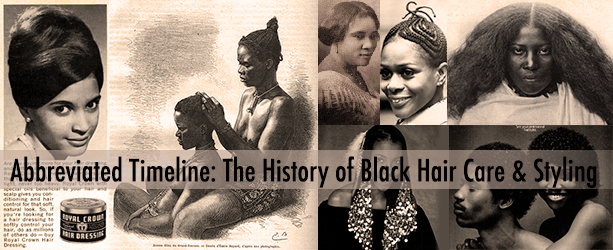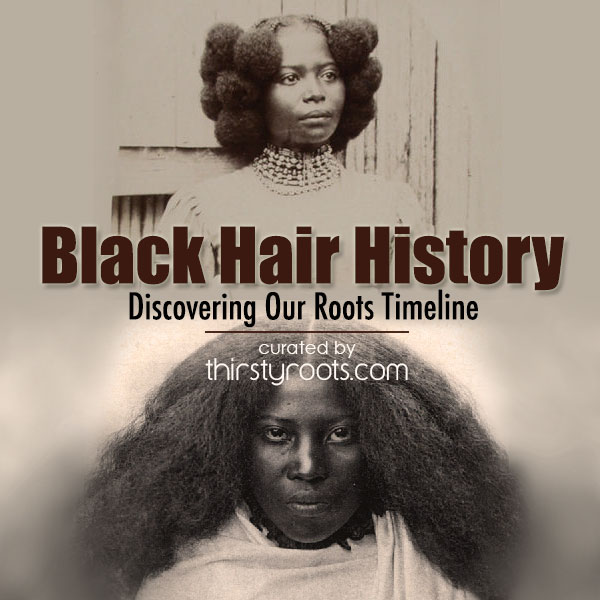

I know the title of this article is a question that we as African Americans have thought about whether through frustration with a “bad hair” day or looking at someone’s hair and wanting your own to look like or perform like theirs. I am sure many other cultures have had the same thoughts, but is there an underlining issue with African Americans?
I thought it would be a good time to raise the awareness of the “hair issues” African Americans have had over the years due to our past. These issues have affected, whether we like it or not, more than just our hair esteem, but in the words of writer Karsten Ivey in an article he wrote called Combing the history of black hair, “It’s about self-esteem, identity, politics, economics, history and race.”
Take the time to read through this abbreviated version of the black hair timeline from the book, Hair Story: Untangling the Roots of Black Hair in America by Ayana Byrd and Lori Tharps, and you will see the facts are an eye opener. This is not to divide anyone or to drive hate, but to educate ourselves and be enlighten to see that we have to take back our love for our Thirsty Roots and love our hair as a whole and love it individually. Let’s define our beauty through our own creativity and natural talents.
Let’s join together and begin changing society’s view of Black Beauty. Let’s join together to take back our definition of beauty in our hair, skin color, and culture. Let’s do this for our kids and generations to come.
Throw away the hate and learn to Love Our Thirsty Roots! In essence, loving on our hair, simple means to educate ourselves about how to properly take care of and maintain healthy hair.
Abbreviated Timeline
| Africans – Photo Source: http://www.dipity.com/westcivg/personal/ |
| 1444: Europeans trade on the West Coast of Africa with people wearing elaborate hairstyles, including locks, plaits and twists. |
| Slaves Arrival at Jamestown – Photo Source: http://www.henryrobertburke.com/id4.html |
| 1619: First slaves brought to Jamestown; African language, culture and grooming tradition begin to disappear. |
| Olaudah Equiano, aka Gustavus Vassa – First published in 1789 – Photo Source: http://en.wikipedia.org |
| 1700s: Calling black hair “wool,” many whites dehumanize slaves. The more elaborate African hairstyles cannot be retained. |
| Family on Smith’s Plantation, Beaufort, South Carolina, circa 1862. Photo Source: http://en.wikipedia.org |
| 1800s: Without the combs and herbal treatments used in Africa, slaves rely on bacon grease, butter and kerosene as hair conditioners and cleaners. Lighter-skinned, straight-haired slaves command higher prices at auction than darker, more kinky-haired ones. Internalizing color consciousness, blacks promote the idea that blacks with dark skin and kinky hair are less attractive and worth less. |
| Fisk graduates from the 1880s – Photo Source: http://www.tnhistoryforkids.org/stories/college_histories |
| 1865: Slavery ends, but whites look upon black women who style their hair like white women as well-adjusted. “Good” hair becomes a prerequisite for entering certain schools, churches, social groups and business networks. |
| Photo Source: “Hair Styling By Electricity” – http://homepage.ntlworld.com/paul.linnell/sso_01/hairstyling.htmlPhoto Source: “Hair Styling By Electricity” – http://homepage.ntlworld.com/paul.linnell/sso_01/hairstyling.html |
| 1880: Metal hot combs, invented in 1845 by the French, are readily available in the United States. The comb is heated and used to press and temporarily straighten kinky hair. |
| Madame C.J. Walker Hair Care Products Advertisement – Book Reference: “On Her Own Ground: The Life and Times of Madam C.J. Walker” By A’Lelia Bundles – www.MadamCJWalker.com |
| 1900s: Madame C.J. Walker develops a range of hair-care products for black hair. She popularizes the press-and-curl style. Some criticize her for encouraging black women to look white. |
| Madame C.J. Walker |
| 1910: Walker is featured in the Guinness Book of Records as the first American female self-made millionaire. |
| Marcus Garvey – publisher, journalist, entrepreneur, and orator Photo Source: http://www.africawithin.com/garvey/garvey_bio.htm |
| 1920s: Marcus Garvey, a black nationalist, urges followers to embrace their natural hair and reclaim an African aesthetic. |
| George E. Johnson, Sr. |
| 1954: George E. Johnson launches the Johnson Products Company with Ultra Wave Hair Culture, a “permanent” hair straightener for men that can be applied at home. A women’s chemical straightener follows. |
| Cicely Tyson – Jet Magazine Cover 1973 |
| 1963: Actress Cicely Tyson wears cornrows on the television drama “East Side/West Side.” |
| Model Pat Evans shaved head |
| 1966: Model Pat Evans defies both black and white standards of beauty and shaves her head. |
| Diahann Carroll & Marc Copage – “Julia” 1968 Poster |
| 1968: Actress Diahann Carroll is the first black woman to star in a television network series, “Julia.” She is a darker version of the all-American girl, with straightened, curled hair. |
| Angela Davis Afro |
| 1970: Angela Davis becomes an icon of Black Power with her large Afro. |
| Melba Tolliver on the White House lawn shooting the report of Tricia Nixon’s rose garden wedding 1971 – Photo Source: http://www.melbatolliver.com/backintheday.htm |
| 1971: Melba Tolliver is fired from the ABC affiliate in New York for wearing an Afro while covering Tricia Nixon’s wedding. |
| Jheri curl – Super Curl ad, circa 1980’s. |
| 1977: The Jheri curl explodes on the black hair scene. Billed as a curly perm for blacks, the ultra moist hairstyle lasts through the 1980s. |
| Bo Derek braids with beads in the1979 comedy film “10” |
| 1979: Braids and beads cross the color line when Bo Derek appears with cornrows in the movie “10.” |
| Grace Jones 1980s flattop fade |
| 1980: Model-actress Grace Jones sports her trademark flattop fade. |
| School Daze Film Poster 1988 |
| 1988: Spike Lee exposes the good hair/bad hair light-skinned/dark-skinned schism in black America in his movie “School Daze.” |
| Janet Jackson March 1990 Essence Magazine Cover |
| 1990: “Sisters love the weave,” Essence magazine declares. A variety of natural styles and locks also become more accepted. |
| Erykah Badu “Baduizm” Album Cover |
| 1997: Singer Erykah Badu poses on the cover of her debut album “Baduizm” with her head wrapped, ushering in an eclectic brand of Afrocentrism. |
| Jet Magazine Sep 18, 2000 Dark & Lovely Article |
| 1998: Carson Inc., creator of Dark & Lovely and Magic Shave for black men, acquires black-owned beauty company Johnson Products of Chicago in 1998. L’Oreal purchases Carson two years later and merges it with Soft Sheen. |
| Lauryn Hill People Magazine May 1999 Photo Source: http://www.people.com/people/archive/article/0,,20128144,00.html |
| 1999: People magazine names lock-topped Grammy award-winning artist Lauryn Hill one of its 50 Most Beautiful People. |
| The Notorious K.I.M. – Lil Kim June 2000 Album Cover |
| 2001: Rapper Lil’ Kim wears a platinum blonde weave, while singer Macy Gray sports a new-school Afro. Some black women perm, some press, others go with natural twists, braids and locks. |
| Black Hair Beauty Supply Store |
| 2006: Black hair care is a billion-dollar industry. |

